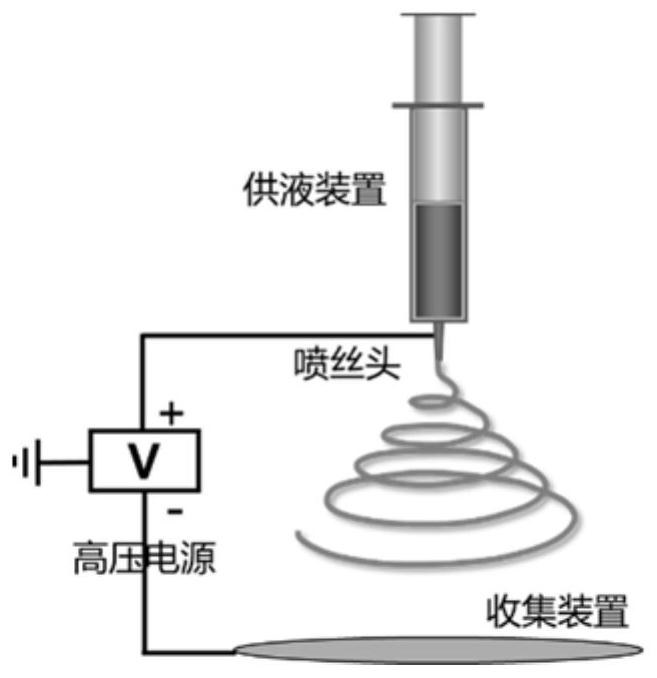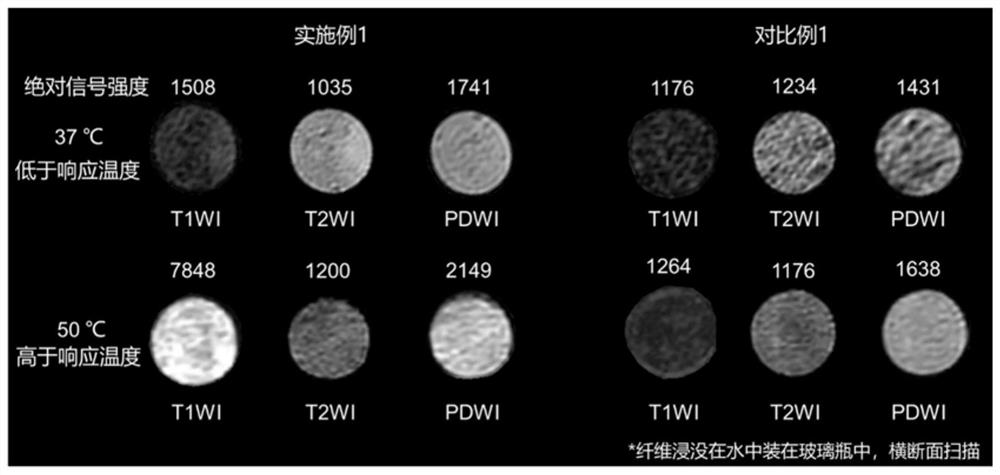Nonmetal temperature-responsive magnetic resonance imaging composite material as well as preparation method and application thereof
A temperature-responsive, magnetic resonance imaging technology, used in pharmaceutical formulations, preparations for in vivo experiments, etc., can solve problems such as limited application, inability to directly reflect cell proliferation, allergies, etc.
- Summary
- Abstract
- Description
- Claims
- Application Information
AI Technical Summary
Problems solved by technology
Method used
Image
Examples
Embodiment 1
[0058] Polybutylene succinate was dissolved in chloroform to form a polymer solution with a mass concentration of 60%, and lauric acid was dissolved in dichloromethane to form a contrast agent solution with a mass concentration of 75%; The spinning solution was obtained after mixing in a ratio of 1:2.
[0059] Electrospin the solution through the following parameters, the liquid supply rate of the liquid supply device is 3mL / h, the distance between the spinneret and the collection device is 20cm, the high voltage of 20kV is connected to the spinneret, and the high voltage of -1kV is connected to the collection device.
[0060] The collected composite fiber product is dried, immersed in water, and the air in the fiber is exhausted.
[0061] The response temperature of the fibers was 44.2°C, as measured by differential scanning calorimetry.
Embodiment 2
[0063] Polyethylene terephthalate was dissolved in chloroform to form a polymer solution with a mass concentration of 45%, and lauryl alcohol was dissolved in dichloromethane to form a contrast agent solution with a mass concentration of 75%; The spinning solution was obtained after mixing in a mass ratio of 1:2.
[0064] Electrospin the solution through the following parameters, the liquid supply rate of the liquid supply device is 3mL / h, the distance between the spinneret and the collection device is 20cm, the high voltage of 20kV is connected to the spinneret, and the high voltage of -1kV is connected to the collection device.
[0065] The collected composite fiber product is dried, immersed in water, and the air in the fiber is exhausted.
[0066] The response temperature of the fibers was 24.0°C as measured by differential scanning calorimetry.
[0067] In order to illustrate that the organic hydrogen-containing molecular contrast agent used in the present invention prov...
Embodiment 3
[0069] Dissolving polyvinyl alcohol in water to form a polymer solution with a mass concentration of 5%, and dissolving glycerol trimyristate in tetrahydrofuran to form a contrast agent solution with a mass concentration of 60%; the two solutions were mixed in a mass ratio of 1:2 After mixing, a spinning solution is obtained.
[0070] Electrospin the solution through the following parameters, the liquid supply rate of the liquid supply device is 0.1 mL / h, the distance between the spinneret and the collecting device is 50 cm, the high voltage 50kV is connected to the spinneret, and the high voltage -1kV is connected to the collecting device.
[0071] The collected composite fiber product is dried, immersed in water, and the air in the fiber is exhausted.
[0072] The response temperature of the fibers was 56.2°C as measured by differential scanning calorimetry.
PUM
 Login to View More
Login to View More Abstract
Description
Claims
Application Information
 Login to View More
Login to View More - R&D
- Intellectual Property
- Life Sciences
- Materials
- Tech Scout
- Unparalleled Data Quality
- Higher Quality Content
- 60% Fewer Hallucinations
Browse by: Latest US Patents, China's latest patents, Technical Efficacy Thesaurus, Application Domain, Technology Topic, Popular Technical Reports.
© 2025 PatSnap. All rights reserved.Legal|Privacy policy|Modern Slavery Act Transparency Statement|Sitemap|About US| Contact US: help@patsnap.com



